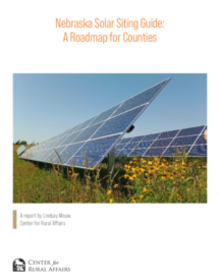Solar at all scales is a growing opportunity in Nebraska. From immense growth in residential solar to the emergence of utility-scale and community projects, solar energy in Nebraska is forecasted to increase considerably.
Counties presented with the opportunity for large-scale solar projects should consider well-drafted regulations, which will address how and where solar systems can be built to preserve the safety and interests of the county and its residents while upholding private property rights and allowing for cost-effective project development.
Nebraska’s first utility-scale solar project came online in 2016 with a 3.6-megawatt project in Lincoln. Multiple projects are in the works now, and at the start of 2023 there were 5,502 megawatts (MW) of potential solar projects being studied statewide for connection to the grid by regional grid operator Southwest Power Pool.
This guide focuses on siting practices for utility-scale solar, with some considerations for community solar. These recommendations do not apply to residential solar energy systems, such as those used at homes, farms, and businesses to produce electricity for usage on-site.
While large-scale solar development may be in its early days, a handful of Nebraska counties have already adopted solar regulations and have seen utility-scale development. In addition to looking at existing Nebraska regulations, we have reviewed regulations and best practices from neighboring states and identified specific provisions local officials can use as a road map for their own.
We encourage counties considering or updating solar regulations to use this guide as a reference to support the development and adoption of well-designed zoning regulations rooted in existing successful practices.
This document is not legal advice, and users of this guide should consult an attorney with any legal questions.


